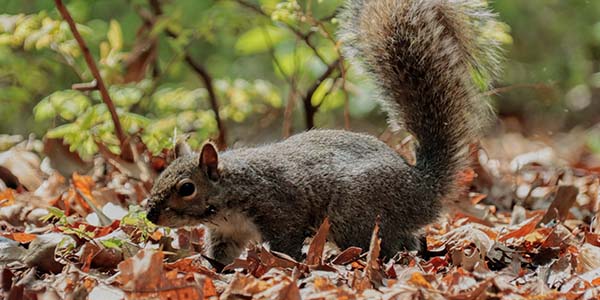Squirrels are mammals and as such, they establish territories and must roam to find food and water to survive. But how far do they actually roam? This article will explore, squirrel territories, home ranges, roaming behaviors, and the different factors that contribute to squirrel movement.
Squirrel’s Home Range
First, it’s important to understand exactly what this ‘roaming’ means in terms of where squirrels live. They do not wander aimlessly; instead, they establish home ranges (areas which they consider their territory) within larger territories known as habitats or areas. The size of these varies among species but can range from about 200 sq. ft. for smaller varieties like American red squirrels, up to around 25 acres for the grey squirrels.
What Does a Squirrel’s Range Look Like?
Squirrel range is often described in terms of density, or how many there are within a certain area. This will depend on the habitat that they live in as well as other factors like food availability, predators, etc. A dense population of squirrels may be found where their needs are met i.e. There are ample sources of food, water, and shelter for them to survive comfortably while less dense populations can be found where these resources are scarce.
When determining an average distance between each animal it helps to use something called home ranges which measure all areas used by one specific individual during a squirrel’s lifetime. Home ranges usually vary depending upon environmental conditions including weather patterns (temperature), availability of food and water, presence or absence of predators, hunting, among others.
Where Do Squirrels Roam?
For most types of squirrel, ranging will be mostly limited to an area surrounding their den site (where they sleep). Some individuals may make longer journeys away from the den site though if food sources are scarce. In this case, they can range much further afield and will often be more active during the day because their feeding activity is not restricted to nighttime hours.
How Big Is A Squirrel’s Territory?
The size of a squirrel territory can be between one and 25 acres. Squirrel territories frequently overlap but squirrels typically avoid each other outside of mating season. The size varies depending on many factors, but it’s usually around this area for most individuals.
How Far Do They Roam?
The average distance that a squirrel will range from its den site is generally 1 to 2 miles. However, the home ranges for each individual can vary considerably depending on several factors such as:

- Type of habitat
- Population density
- Species
- Food availability
- Level of predation
- Age
- Mating season
- Climate and weather conditions
Type of habitat
Urban squirrels, for example, won’t have to travel far to find food, they can raid a bird feeder or trash cans as in the case of gray squirrels in residential areas. Squirrels that live in forests, on the other hand, may have to travel further to find acorns or nuts as food sources.

Population densities
If there are a lot of squirrels in one area, they will compete for available resources and so the ones who aren’t as resourceful or strong might need to travel further than their more dominant compatriots. If an individual’s home range is smaller it may be due to this reason too; he simply doesn’t have space to roam around! This can also lead larger populations into traveling greater distances in order to establish new territories with plentiful food sources and few competitors.
Species
The size of a gray squirrel or red fox territory can vary greatly depending on several factors such as age (adults usually roam more), gender (males range over a larger area than females do) among others including the availability of food/water, etc. Types like American red squirrels will typically only travel up to about 200 sq ft whereas grey squirrels may range around 25 acres. Larger squirrels such as gray foxes tend to roam much further than smaller ones like red and Douglas squirrels. Tree squirrels are also generally more mobile than ground squirrels and tend to travel further.

Food availability
If the squirrel has a plentiful food supply in his immediate area, he will have less reason to range further and therefore is likely to stay closer. In areas where there are fewer food sources available, or if these become scarce during certain seasons (for instance winter), then they may need to travel farther from their homes. This can mean that while some individuals of one species might not go far at all, others could be moving up to ten miles away!

Level of predation
This is a significant factor in areas where predators are prevalent. If there’s a high chance of being attacked by another animal, the squirrel will naturally be more cautious and may not go as far from its den site so it can avoid potential danger.
Age
Adults will typically range further than juveniles because they have to find food for themselves whereas younger animals are still quite cautious about their surroundings and tend to stick closer to the nest.
Mating season
During the mating season, males may range further than usual to find females and mate with them and females may range further than usual in order to find food and raise their cubs.
Climate & weather conditions
If the climate is very cold then squirrels will need to stay closer to sources of water, shelter from harsh elements (for instance snow), and other resources that they require such as pine cones for winter stockpiling. Squirrels will often follow the same routes every day, even when it’s raining or snowing because they know these areas well; however, if a winter is particularly bad, they may choose to stay closer to home.

How Far Do Squirrels Travel in a Day?
Squirrels can travel 2 miles per day! When they go further it means they’re not coming back and are “emigrating” to a new place. Squirrel range will also depend on the time of year as well as what types of food are readily available during a given season. This can affect how far a squirrel needs to travel and for how long each day until it has found enough food to survive.
Are Squirrels Solitary Animals?
Most squirrels are somewhat solitary animals. They keep to themselves, except for the mating season when they become very territorial and aggressive towards other squirrels in their range. A male may have up to three females living within his territory, but he will fiercely protect them from any invader or competitor that tries to encroach on it.
Are Squirrels Territorial
Squirrels can be territorial but not to the same degree as some other animals. They have hierarchies of dominance that they adhere to when in the presence of others. In some cases, they do establish boundaries (or territories) within their home range and mark it with scent markings.
Often, more dominant males will have larger territories than their subordinates and the female’s home ranges are always smaller. The exception to this is female flying squirrels which are more territorial than male flying squirrels and will often fight to protect their territory.
Squirrel territories frequently overlap but they are certainly very aware of each other’s presence and will defend their territory if necessary. Male squirrels, in particular, have been known to chase off any competitor that encroaches upon his turf whether or not there is a female living within it!
Do Squirrels Migrate?
Squirrels travel but they do not migrate in the same way other animals do. Migratory animals travel long distances to take advantage of the changing seasons but they always come back to their home territory.
Squirrels on the other hand will simply take up residence in a new territory if they needed to. If the squirrel’s original home becomes too dangerous because of predators, food scarcity, overpopulation, or some other factor that makes it difficult for them to survive then they will simply move to a new place and settle there instead.
Researchers call this behavior emigration as opposed to migration. It’s similar to migration in that the squirrel will need to travel a fairly long distance but it is not done for seasonal changes.
Squirrel Relocation
When releasing squirrels it is important to take the same precautions you would for moving any other wild animal. The main reason squirrels are moved in the first place is because they have become a nuisance or gotten into something that makes them dangerous or unwelcome at their current location.
You would typically need at least 15 miles from their former nesting ground so the squirrel doesn’t find its way back. However, it is important to remember that you will need more than this if the new territory has poor resources for squirrels so they won’t want to stay there in the first place!
If you have any questions about removing nuisance squirrels, please feel free to contact AAAC Wildlife Removal.
Conclusion
How far squirrels roam actually depends on many factors, some of which are more significant than others. For example, if they have plentiful food sources in the area where they live it may not be necessary for them to roam far at all since their needs are being met!
However, this can also mean that when there’s a shortage of food during the winter months, these individuals may need to go further from home and into areas occupied by other squirrels which could lead to conflict between animals competing for available resources.
Similarly, larger species will tend to range more widely because they’re less likely to be attacked by predators so the risk is lower; smaller ones with specific habitats or prey items might never leave just one square kilometer! There are many factors involved but essentially how much an individual roams depends on his own particular circumstances making each case unique.
Originally published on https://aaacwildliferemoval.com/blog/squirrels/how-far-do-squirrels-roam



